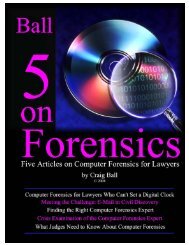Litigator's Guide to Metadata - Codemantra.net
Litigator's Guide to Metadata - Codemantra.net
Litigator's Guide to Metadata - Codemantra.net
- No tags were found...
You also want an ePaper? Increase the reach of your titles
YUMPU automatically turns print PDFs into web optimized ePapers that Google loves.
A lawyer’s ability <strong>to</strong> advise a client about how <strong>to</strong> find, preserve and produce metadata, or <strong>to</strong> object<strong>to</strong> its production and discuss or forge agreements about metadata, hinges upon how well he orshe understands metadata.It’s Just Ones and ZeroesUnderstanding metadata and its importance in e-discovery begins with awareness that electronicdata is, fundamentally, just a series of ones and zeroes. Though you’ve surely heard that before,you may not have considered the implications of information being expressed so severely. Thereare no words. There are no spaces or punctuation. There is no delineation of any kind.How, then, do computers convert this unbroken sequence of ones and zeroes in<strong>to</strong> information thatmakes sense <strong>to</strong> human beings? There has <strong>to</strong> be some key, some coherent structure imposed <strong>to</strong>divine their meaning. But where does it come from? We can’t derive it from the data if we can’tfirst make sense of the data.It’s EncodedConsider that written English conveys all information using fifty-two upper- and lowercase lettersof the alphabet, ten numerical digits (0-9), some punctuation marks and a few formattingconventions, like spaces, line feeds, pages, etc. You can think of these collectively as a seventyoreighty-signal ―code.‖ In turn, much of the same information could be communicated or s<strong>to</strong>red inMorse code, where a three-signal code composed of dot, dash and pause serves as the entire―alphabet.‖We’ve all seen movies where a tapping sound is heard andsomeone says, ―Listen! It’s Morse code!‖ Suddenly, thetapping is an encoded message because someone hasfurnished metadata (―It’s Morse code!‖) about the data (tap,tap, pause, tap). Likewise, all those ones and zeroes on acomputer only make sense when other ones and zeroes—themetadata—communicate the framework for parsing andinterpreting the data stream.All those ones and zeroeson a computer only makesense when other ones andzeroes—the metadata—communicate theframework for parsing andinterpreting the datastream.So, we need data about the data. We need information that tells us the data’s encoding scheme.We need <strong>to</strong> know when information with one purpose ends and different information begins. Andwe need <strong>to</strong> know the context, purpose, timeliness and origin of information for it <strong>to</strong> help us. That’smetadata.The <strong>Metadata</strong> ContinuumSometimes metadata is elemental, like the contents of a computer’s master file table detailingwhere the sequences of one and zeroes for particular files begin and end. This metadata isinvisible <strong>to</strong> a user without special <strong>to</strong>ols called hex edi<strong>to</strong>rs capable of peering through the walls ofthe Windows interface in<strong>to</strong> the utilitarian plumbing of the operating system. Without file locationmetadata, every time a user tries <strong>to</strong> access a file or program, the operating system would have <strong>to</strong>examine every one and zero <strong>to</strong> find it. It’d be like looking for someone by knocking on every doorin <strong>to</strong>wn!3













